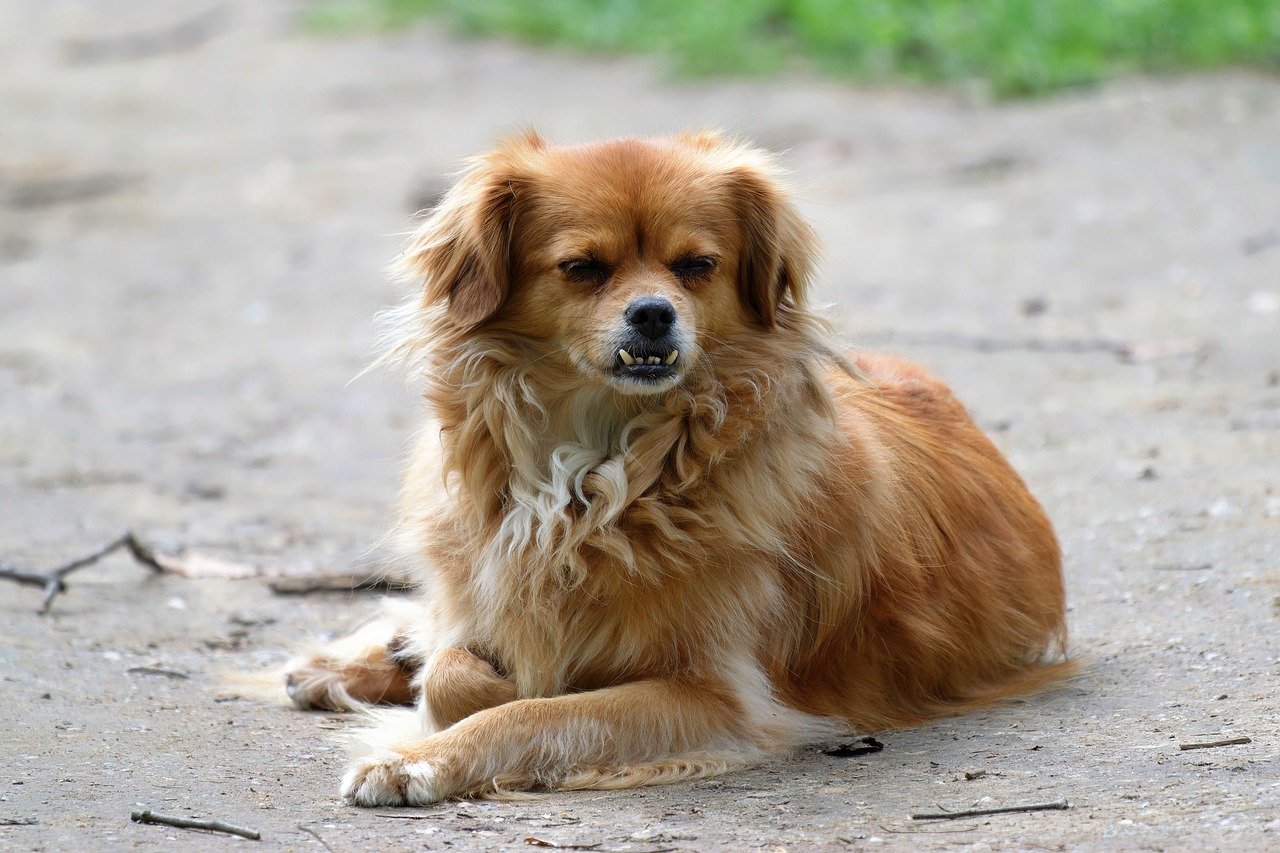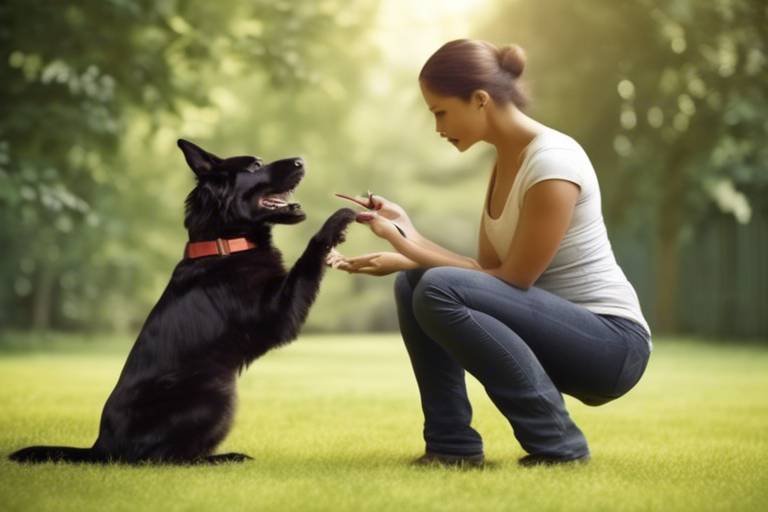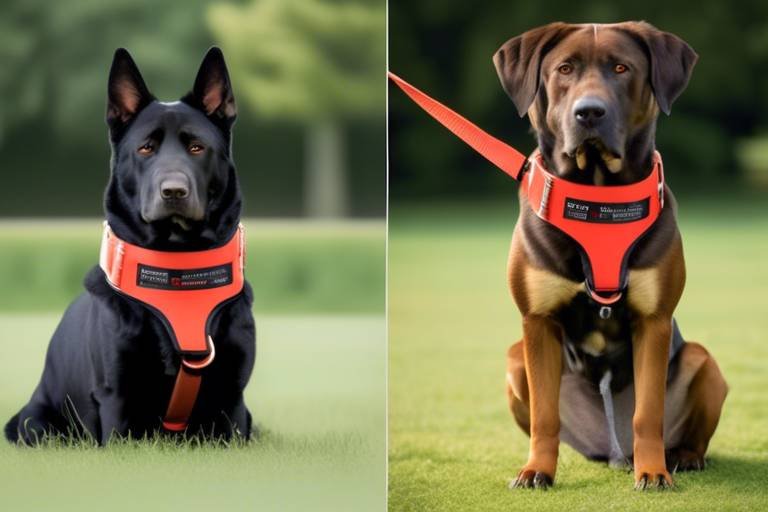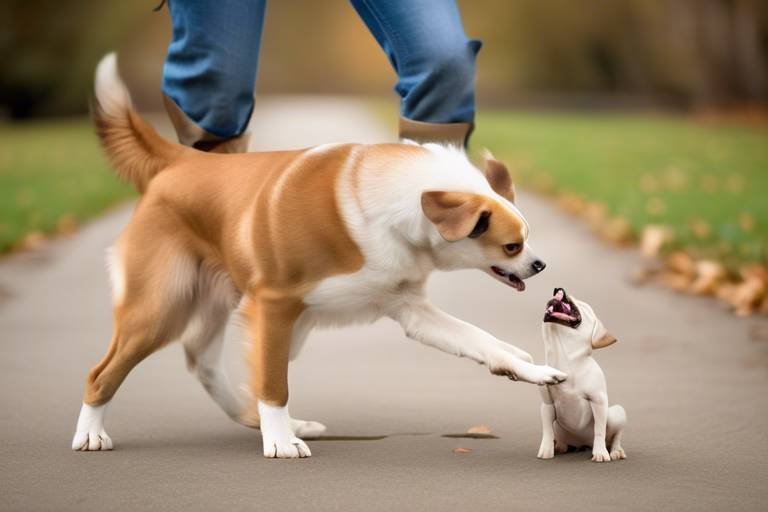How to Help Your Dog with Leash Pulling
Walking your dog should be a joyful experience, a time to bond and explore the great outdoors together. However, if your furry friend is constantly pulling on the leash, it can turn a pleasant stroll into a frustrating tug-of-war. Leash pulling is not just an annoying habit; it can lead to safety concerns for both you and your dog. So, how can you transform your chaotic walks into peaceful adventures? This article dives into effective strategies and techniques that will help you manage and reduce leash pulling behaviors, ensuring enjoyable walks for both you and your beloved pet.
Before we jump into solutions, it's essential to understand why dogs pull on the leash in the first place. There are several reasons behind this behavior, and recognizing them can help you address the issue more effectively. Many dogs are driven by instinct; they want to explore their surroundings, chase after interesting scents, or simply get to their destination faster. Additionally, a lack of training can exacerbate this pulling tendency. If a dog hasn't learned how to walk politely on a leash, they might think that pulling is the way to go. It's like trying to navigate a busy street without a map—confusing and chaotic!
Now that we understand the reasons behind leash pulling, let's discuss how the right equipment can make a significant difference. Choosing the appropriate collar, harness, and leash can help manage your dog's pulling tendencies effectively. Think of it this way: the right tools can be like having a good pair of shoes for a long hike—essential for a smooth journey!
When it comes to collars, there are several options available, each with its own pros and cons. Here’s a quick overview:
| Type of Collar | Pros | Cons |
|---|---|---|
| Traditional Collars | Simple, affordable | May not prevent pulling |
| Head Collars | Better control over strong pullers | Can be uncomfortable if not fitted correctly |
| No-Pull Collars | Discourages pulling behavior | May require adjustment and training |
Head collars are designed to give you more control over your dog, especially if they are strong pullers. They work by gently guiding your dog's head, making it easier for you to steer them in the right direction. However, it's crucial to use them properly. Start by allowing your dog to get accustomed to the head collar at home. Gradually introduce it during walks, rewarding them for walking calmly. This way, you can ensure both comfort and effectiveness.
No-pull harnesses are another fantastic option for managing leash pulling. These harnesses are specifically designed to discourage pulling by distributing pressure across your dog's chest rather than their neck. This not only helps in reducing pulling but also keeps your dog safe. When fitting a no-pull harness, ensure it is snug but not too tight; you should be able to fit two fingers between the harness and your dog's body.
The type of leash you use can also influence your dog's behavior. A longer leash might give your dog more freedom to roam but can also encourage pulling. On the other hand, a shorter leash provides better control. Additionally, consider the material of the leash. A sturdy leash made of durable material can withstand pulling without breaking, ensuring a safer experience for both of you. Always opt for a leash that feels comfortable in your hand and suits your dog's size and strength.
Once you've got the right equipment, it's time to implement effective training techniques. These methods are crucial for reducing leash pulling and ensuring that your dog learns to walk politely beside you. Remember, training takes time and patience, but the rewards are well worth it!
Positive reinforcement is a powerful tool in dog training. By rewarding your dog for walking calmly beside you, you encourage them to repeat the behavior. Carry treats with you during walks, and when your dog walks without pulling, offer them a treat and lots of praise. It's like giving them a little high-five for good behavior!
Incorporating specific exercises into your training routine can also be beneficial. For instance, practice the “stop and go” method: when your dog starts to pull, stop walking and wait for them to return to your side. Once they do, reward them and continue walking. This teaches them that pulling gets them nowhere, while walking nicely earns them a fun adventure.
Q: How long does it take to train my dog to stop pulling?
A: The timeline can vary depending on your dog's age, breed, and previous training. Consistent practice and patience are key!
Q: Can I use a regular collar instead of a harness?
A: While you can use a regular collar, a no-pull harness or head collar is often more effective for managing pulling behavior.
Q: What if my dog is still pulling after trying these techniques?
A: If your dog continues to pull, consider consulting a professional dog trainer for personalized guidance.

Understanding Leash Pulling
Leash pulling is a common issue that many dog owners face, and it can turn what should be an enjoyable walk into a frustrating battle of wills. But why does this behavior occur? Understanding the underlying reasons can help you tackle the problem effectively. Dogs are naturally curious creatures, driven by instinctual urges to explore their surroundings. When they see a squirrel, another dog, or even a particularly interesting smell, their natural reaction is to pull forward on the leash. This instinct is deeply rooted in their ancestry as hunters and foragers.
Moreover, leash pulling often stems from a lack of proper training. If a dog hasn't been taught how to walk calmly on a leash, they may not understand that pulling isn't the desired behavior. It's like a child who hasn't learned to share their toys – they may not realize that their actions can be bothersome to others. In this case, the leash becomes a source of tension instead of a tool for companionship.
Another contributing factor is the dog's energy level. High-energy breeds, such as Border Collies or Jack Russell Terriers, may be more prone to pulling simply because they have a lot of pent-up energy. If a dog isn't getting enough exercise, they might see walks as an opportunity to release that energy, leading to a tug-of-war scenario with their owner. It's essential to consider your dog's breed, age, and energy level when addressing leash pulling.
In addition to instinct and energy, the environment plays a significant role. Dogs are highly influenced by their surroundings. If you're walking in a bustling area filled with distractions, it's no wonder your dog might pull! They might be reacting to other dogs, people, or even the sounds of traffic. This sensory overload can lead to excitement and, consequently, pulling on the leash.
To sum it up, leash pulling is a multifaceted issue that can arise from a combination of instinctual drives, lack of training, energy levels, and environmental factors. By understanding these elements, you can develop a tailored approach to help your furry friend learn better leash manners. Remember, patience and consistency are key. Just like teaching a child to ride a bike, it may take time and practice, but the reward of a peaceful walk is well worth the effort!

Choosing the Right Equipment
When it comes to managing your dog's leash pulling, one of the most critical factors to consider is the equipment you use. The right gear can make a world of difference, transforming your walks from a chaotic tug-of-war into a pleasant stroll. Think of it like choosing the right tools for a job; just as you wouldn’t use a butter knife to cut a steak, you don’t want to use the wrong collar or leash for your furry friend. Let’s dive into the various options available and how they can help you and your pup.
First up, we have collars. Traditional collars are the most common choice, but they aren't always the best option for dogs that pull. They can sometimes cause discomfort or even injury if your dog is a strong puller. On the other hand, head collars offer a different approach. They fit around your dog's muzzle and give you more control over their head movements. This can be especially useful for larger breeds that tend to pull hard. However, it's essential to introduce them gradually to avoid any resistance from your dog.
Next, let's talk about no-pull harnesses. These are specifically designed to discourage pulling behavior by distributing pressure across your dog's body instead of just their neck. This can be a game-changer for both you and your dog. When fitted correctly, a no-pull harness can help your dog learn to walk calmly beside you without the discomfort that traditional collars can cause. It's like giving your dog a gentle reminder to stay close rather than yanking them back with a collar.
Now, let’s not forget about the leash itself. The type of leash you choose can significantly influence your dog's behavior on walks. For instance, a long leash might give your dog more freedom to explore, but it can also lead to more pulling if they get too excited. A shorter leash, on the other hand, allows for better control but can feel restrictive for your dog. Think of it as a balance; you want to give them enough freedom to enjoy their walk while maintaining control to reduce pulling.
| Type of Equipment | Pros | Cons |
|---|---|---|
| Traditional Collars | Common, easy to find | Can cause neck injury, not ideal for pullers |
| Head Collars | Better control, reduces pulling | Can be uncomfortable if not fitted properly |
| No-Pull Harnesses | Comfortable, encourages good behavior | May require proper fitting and adjustment |
| Leash (Short vs Long) | Short leashes provide control; long leashes allow exploration | Short leashes can feel restrictive; long leashes can lead to tangling |
In summary, selecting the right equipment is a vital step in addressing leash pulling. Each option comes with its own set of advantages and disadvantages, so it’s essential to consider your dog's personality, size, and pulling tendencies when making a choice. Just like how a good pair of shoes can make a long walk more enjoyable, the right collar, harness, and leash can transform your daily outings with your dog into a delightful experience.
Types of Collars
When it comes to managing your dog's leash pulling, choosing the right collar is paramount. There are several types of collars available, each with its own purpose and effectiveness. Understanding these options can help you make an informed choice that suits your dog's needs and your walking style. Let's dive into the most common types of collars:
Traditional Collars are perhaps the most familiar type. These collars are typically made of nylon or leather and are designed to hold your dog's identification tags and leash. While they're great for everyday use, they often don't provide enough control for dogs that pull. In fact, if your dog is strong or excitable, a traditional collar might actually encourage pulling, as they can easily slip out of them or yank hard enough to cause discomfort.
Head Collars, on the other hand, are designed to give you better control over your dog's head and, by extension, their body. They work similarly to a halter for a horse, allowing you to guide your dog more effectively. This can be a game changer for strong pullers! However, it's essential to introduce head collars gradually, as some dogs may find them uncomfortable at first. Proper fitting and acclimation are key to ensuring your dog accepts this new gear.
No-Pull Collars are specifically designed to discourage pulling behavior. These collars often feature a unique mechanism that tightens slightly when the dog pulls, gently reminding them to stop. While they can be effective, it's crucial to use them correctly and not to rely solely on them for training. Think of them as a tool in your training arsenal rather than a permanent solution. It's always best to combine the use of no-pull collars with positive reinforcement and consistent training methods.
| Type of Collar | Pros | Cons |
|---|---|---|
| Traditional Collar | Simple, affordable, and widely available. | Can encourage pulling; may slip off easily. |
| Head Collar | Provides excellent control; effective for strong pullers. | May be uncomfortable for some dogs; requires proper fitting. |
| No-Pull Collar | Discourages pulling; can be effective when used properly. | Requires training; should not be a long-term solution. |
Ultimately, the best collar for your dog will depend on their size, strength, and behavior. It's often helpful to consult with a professional trainer or your veterinarian to find the right fit for your furry friend. Remember, the goal is not just to stop the pulling but to create a more enjoyable walking experience for both you and your dog!
Head Collars
Head collars are a fantastic tool for dog owners who struggle with managing strong pullers during walks. These collars work by gently guiding your dog's head, which in turn influences their body direction. Think of it like steering a car; if you turn the steering wheel, the whole vehicle follows. Similarly, when you guide your dog's head with a head collar, their body naturally follows, making it easier for you to control their movements.
One of the most significant advantages of head collars is that they provide better control over your dog without causing discomfort or harm. Unlike traditional collars that can put pressure on the neck, head collars distribute pressure more evenly across the dog's head and muzzle. This design not only enhances comfort but also ensures that you have a firmer grip on your dog, especially if they are prone to sudden bursts of energy.
However, it's essential to introduce a head collar to your dog gradually. Some dogs may initially resist wearing one, so patience is key. Start by letting your dog sniff and explore the collar before putting it on them. Once they are comfortable, you can begin using it during short walks. Always remember to pair the head collar with positive reinforcement; rewarding your dog with treats and praise when they walk calmly will help them associate the collar with positive experiences.
To ensure that the head collar is both effective and comfortable, it's crucial to fit it correctly. A poorly fitted collar can lead to discomfort and even injury. Here’s a quick guide on how to fit a head collar:
| Step | Description |
|---|---|
| 1 | Place the collar around your dog's nose and adjust the strap behind their ears. |
| 2 | Make sure it’s snug but not too tight; you should be able to fit two fingers between the collar and your dog's skin. |
| 3 | Check that the collar allows for natural movement of the jaw; your dog should still be able to pant and drink water comfortably. |
In conclusion, head collars can be a game-changer for dog owners dealing with leash pulling. By providing better control and enhancing comfort, they allow for more enjoyable walks. Just remember to introduce the collar slowly and ensure a proper fit to maximize its effectiveness.
- Are head collars safe for all dogs? Yes, head collars are generally safe for most dogs, but it's essential to monitor their comfort and adjust the fit as needed.
- How long does it take for a dog to get used to a head collar? The time varies by dog, but many can adapt within a few days to a couple of weeks with proper introduction and positive reinforcement.
- Can head collars be used for training? Absolutely! They can be an effective training tool, especially for teaching dogs not to pull on the leash.
No-Pull Harnesses
No-pull harnesses are a fantastic tool for dog owners looking to tackle the challenge of leash pulling. Unlike traditional collars that can put pressure on your dog's neck, no-pull harnesses distribute the pulling force across the dog's chest and back. This design not only prevents injury but also discourages the pulling behavior itself. Imagine trying to steer a car by pulling on the steering wheel; it’s much easier to guide it gently from the side. Similarly, a no-pull harness allows you to guide your dog without causing discomfort.
These harnesses typically feature a front clip attachment that redirects your dog's movement when they pull. When your pup tries to surge ahead, the harness gently pulls them back toward you, teaching them that pulling doesn’t lead to the exciting adventure they were hoping for. It’s a win-win situation! But not all no-pull harnesses are created equal; it’s essential to choose one that fits your dog properly. An ill-fitting harness can lead to chafing or even escape, which can turn your walk into a chase!
When selecting a no-pull harness, consider the following factors:
- Fit: The harness should be snug but not too tight. You should be able to fit two fingers between the harness and your dog's body.
- Material: Look for durable, breathable fabrics that won’t irritate your dog’s skin.
- Adjustability: A harness with adjustable straps can provide a better fit as your dog grows or changes shape.
To ensure the best results, it’s crucial to introduce the harness to your dog gradually. Let them wear it around the house for short periods before heading out for a walk. This way, they can get used to the sensation without feeling overwhelmed. Once they’re comfortable, you can start incorporating positive reinforcement. Every time your dog walks nicely beside you, reward them with treats or praise. Over time, they’ll associate the harness with positive experiences, making walks far more enjoyable for both of you.
In conclusion, no-pull harnesses can be a game-changer for dog owners struggling with leash pulling. They provide a safe, humane way to manage your dog's behavior while ensuring their comfort. With the right fit and a little training, you’ll be able to turn those chaotic walks into peaceful strolls, allowing you to enjoy your time outdoors together.
Q: Can any dog use a no-pull harness?
A: Yes, most dogs can benefit from a no-pull harness, but it’s important to choose the right size and style for your dog’s breed and temperament.
Q: How do I know if the harness fits correctly?
A: A properly fitted harness should allow for two fingers to fit comfortably between the harness and your dog's body. It shouldn’t be so loose that your dog can escape or so tight that it causes discomfort.
Q: Will a no-pull harness stop my dog from pulling completely?
A: While a no-pull harness can significantly reduce pulling, it’s essential to pair it with training techniques to teach your dog proper leash manners.
Q: Can I use a no-pull harness for training?
A: Absolutely! No-pull harnesses are great for training, especially when combined with positive reinforcement methods.
Leashes: Length and Material
When it comes to managing your dog's pulling tendencies, the type of leash you choose plays a pivotal role. It's not just about having something to hold onto; it's about finding the right balance between control and comfort for both you and your furry friend. A leash can be your best ally or your worst enemy during walks, so let's dive into the important factors of length and material.
First off, let's talk about leash length. The standard leash length is typically around 6 feet, which offers a good amount of control while allowing your dog some freedom to sniff and explore. However, shorter leashes can be beneficial if your dog is a strong puller. They keep your pup closer, reducing the chance of lunging at distractions. On the other hand, longer leashes, like the 10 to 15-foot varieties, can be great for training purposes or allowing your dog to roam in safe, open areas. Just remember, with great length comes great responsibility—longer leashes can lead to tangles and less control.
Now, let’s not overlook the material of the leash. Leashes can be made from a variety of materials, each with its pros and cons. Here’s a quick breakdown:
| Material | Pros | Cons |
|---|---|---|
| Nylon | Durable, lightweight, and comes in various colors | Can fray over time; may not be suitable for strong pullers |
| Leather | Strong, comfortable grip, and stylish | Can be expensive; requires maintenance to prevent damage |
| Chain | Very strong, ideal for strong pullers | Heavy, can be uncomfortable for both dog and owner |
Choosing the right material is essential for ensuring both your comfort and your dog's safety. For instance, if your dog tends to pull a lot, a chain leash might seem like a good idea due to its strength. However, it can be heavy and uncomfortable to handle. On the flip side, a nylon leash is lightweight and easy to manage, but it may not withstand the force of a strong puller. It’s all about matching the leash to your dog's behavior and your walking style.
In conclusion, selecting the right leash length and material is crucial for effective leash management. It's not just about aesthetics or comfort; it’s about ensuring that every walk is a pleasant experience for both you and your dog. So, before you head out for your next adventure, take a moment to evaluate your leash options. You might be surprised at how the right leash can transform your walks from chaotic to calm!
- What is the best leash length for my dog? A 6-foot leash is generally recommended for most situations, allowing good control while giving your dog some freedom.
- Are chain leashes safe for dogs? Yes, but they can be heavy and uncomfortable; consider your dog's strength and pulling habits before choosing one.
- How do I know if my leash is the right material? Evaluate your dog's pulling behavior and your own comfort level; nylon is great for everyday use, while leather offers style and durability.

Training Techniques to Reduce Pulling
When it comes to leash pulling, the right training techniques can make all the difference. Imagine going for a walk with your dog, and instead of feeling like you’re being dragged down the street, you’re enjoying a leisurely stroll together. Sounds dreamy, right? Well, it’s entirely possible with the right approach! The key lies in understanding your dog’s behavior and implementing effective training methods that promote calm walking.
One of the most effective ways to tackle leash pulling is through positive reinforcement. This technique involves rewarding your dog for good behavior, which, in this case, means walking calmly beside you. For instance, every time your dog walks without pulling for a few steps, shower them with praise or a small treat. This not only encourages your dog to repeat the behavior but also strengthens the bond between you two. Remember, dogs thrive on attention and rewards, so make it a fun experience!
Now, let’s dive into some specific leash training exercises that can help teach your dog to walk politely. One popular method is the “stop-and-go” technique. Here’s how it works: when your dog starts to pull, simply stop walking. Stand still and wait for them to return to your side. Once they do, give them a treat or praise, and then start walking again. This exercise teaches your dog that pulling will not get them anywhere, while walking calmly will lead to rewards. It’s a simple yet effective way to reinforce good behavior.
Another useful exercise is the “turn-around” method. If your dog pulls ahead, turn in the opposite direction and walk away. This sudden change will surprise them and encourage them to pay attention to you. Each time they pull, repeat the process. Over time, your dog will learn to stay close to you to avoid the confusion of being turned around. Consistency is key, so make sure to practice this regularly during your walks.
Additionally, incorporating some fun games into your training can also be beneficial. For example, try playing “follow the leader” during your walks. Change your pace, direction, and even stop occasionally. This keeps your dog engaged and encourages them to pay attention to your movements rather than focusing on distractions around them. It’s a great way to turn a mundane walk into an exciting adventure!
Lastly, patience and consistency are your best friends in this journey. Training your dog to stop pulling on the leash won’t happen overnight, but with practice and dedication, you’ll see progress. Celebrate the small victories, and don’t hesitate to seek help from a professional trainer if you’re feeling stuck. Remember, a well-trained dog is a happy dog, and a happy dog means enjoyable walks for both of you!
- How long will it take to train my dog to stop pulling?
The time it takes varies by dog. Consistent training can lead to noticeable improvements within a few weeks.
- Can I use a regular collar for leash training?
While you can, using a no-pull harness or head collar may provide better control and comfort for your dog.
- What if my dog is still pulling despite training?
Consider consulting a professional dog trainer for personalized advice and techniques tailored to your dog's needs.
Positive Reinforcement Methods
When it comes to training your dog to stop pulling on the leash, positive reinforcement is one of the most effective strategies you can adopt. Imagine this: every time your dog walks beside you without pulling, you shower them with praise or a tasty treat. This approach not only makes your dog associate walking calmly with positive outcomes but also strengthens the bond between you two. It's like giving your furry friend a gold star for good behavior!
So, how does this work in practice? First off, it’s essential to choose the right rewards. Some dogs are food-motivated, while others may respond better to toys or affection. You’ll want to experiment a bit to find out what makes your dog wag their tail the fastest. For instance, if your dog loves a particular chew toy, you can use that as a reward when they walk nicely beside you.
Consistency is key in this process. Every time your dog pulls, gently stop walking and wait until they return to your side. Once they do, reward them immediately. This teaches them that pulling doesn’t get them anywhere, while walking calmly does. Over time, they’ll begin to understand that staying close to you is the way to go. It's like a game of tug-of-war, but instead of pulling, you're teaching them to stay close!
To further enhance your training sessions, consider incorporating clicker training into your routine. A clicker is a small device that makes a distinct sound when pressed. It acts as a marker for good behavior. When your dog walks nicely, you click, and then reward them. This method provides immediate feedback, making it clear to your dog what they did right. It’s a bit like saying, “Yes! That’s exactly what I wanted!”
Additionally, keep your training sessions short and fun. Dogs have a shorter attention span than we do, so aim for sessions lasting about 5 to 10 minutes. You can always have multiple short sessions throughout the day. This way, your dog stays engaged and excited about learning. Remember, the goal is to make walks enjoyable for both of you!
Lastly, if your dog gets overly excited or distracted during walks, try to find a quieter area to practice. This will help minimize distractions and allow your dog to focus on you and the training. Just like a child in a noisy classroom, your dog can become overwhelmed by too many stimuli, making it harder for them to learn.
In summary, using positive reinforcement methods is not just about correcting behavior; it’s about creating a positive experience for your dog. By rewarding them for good behavior, you’re paving the way for a more enjoyable walking experience. So grab those treats, put on your walking shoes, and get ready to transform your walks into a fun-filled adventure!
- How long does it take to train my dog to stop pulling? - Training duration varies by dog, but with consistent practice, you should start seeing improvements within a few weeks.
- Can I use treats during every walk? - While it's beneficial to use treats initially, you can gradually reduce them as your dog learns to walk calmly.
- What if my dog is too distracted to focus on training? - Start training in a quiet environment, and gradually introduce distractions as your dog improves.
Leash Training Exercises
When it comes to teaching your dog to walk politely on a leash, engaging in is essential. These exercises not only help to curb the pulling behavior but also strengthen the bond between you and your furry friend. Just like humans benefit from practice and consistency, dogs thrive on routine and positive reinforcement. So, let's dive into some effective exercises that can transform your walks from chaotic to delightful!
One of the most effective exercises is the Stop and Go Method. This technique is simple yet powerful. As you walk, whenever your dog starts to pull, stop immediately in your tracks. This sudden halt will surprise your dog, making them realize that pulling leads to a standstill. Once your dog returns to your side, reward them with a treat and praise. This method teaches them that staying close to you is the way to keep moving forward. Remember, patience is key; it might take a few tries before they catch on!
Another great exercise is the Circle Exercise. This is not just a fun way to train; it also adds a bit of excitement to your walks! Here’s how it works: when your dog starts pulling, instead of moving forward, turn around and walk in a small circle. Your dog will have to adjust to your sudden direction change, which will help them focus on you instead of the environment. Once they are back at your side, praise and reward them. This exercise not only teaches your dog to pay attention but also keeps their interest piqued.
Incorporating distraction techniques is also beneficial. While on your walk, find a spot where you can safely practice commands like “sit” or “stay.” When your dog is focused on you, reward them with treats. This not only reinforces good behavior but also helps them learn to ignore distractions around them. Over time, your dog will associate being calm and focused with positive outcomes.
For a more structured approach, consider a training schedule. Consistency is crucial in leash training. Aim for short training sessions of about 10-15 minutes, focusing on one exercise at a time. You can create a weekly training plan that includes different exercises, ensuring that your dog remains engaged and doesn’t get bored. Here’s a simple example of what your training schedule might look like:
| Day | Exercise | Duration |
|---|---|---|
| Monday | Stop and Go Method | 15 minutes |
| Wednesday | Circle Exercise | 10 minutes |
| Friday | Distraction Techniques | 15 minutes |
Lastly, don’t forget to have fun! Incorporating play into your training sessions can make a world of difference. Dogs are naturally playful creatures, and by turning training into a game, you’ll keep their spirits high and their minds engaged. Use toys or even a game of fetch as a reward for good leash behavior. This will not only help with pulling but also make your walks something your dog looks forward to.
In summary, leash training exercises are a fantastic way to help your dog learn to walk politely by your side. By using techniques like the Stop and Go Method, Circle Exercise, and distraction techniques, you can create a positive and enjoyable walking experience for both you and your dog. Remember, the key is consistency, patience, and a sprinkle of fun!
Q: How long will it take for my dog to stop pulling on the leash?
A: The time it takes varies from dog to dog. With consistent training, many dogs show improvement within a few weeks.
Q: Can I use a retractable leash during training?
A: It's best to avoid retractable leashes during training as they can encourage pulling. Opt for a standard leash for better control.
Q: What if my dog is too excited to focus on training?
A: Try training in a quieter environment with fewer distractions. Gradually increase the level of distractions as your dog becomes more focused.
Frequently Asked Questions
-
What causes my dog to pull on the leash?
Leash pulling is often driven by a dog's natural instincts, excitement, or a lack of proper training. Dogs are curious creatures and can become easily distracted by sights, sounds, and smells, leading them to pull ahead. Additionally, if they haven't been taught how to walk calmly on a leash, they may not understand that pulling is undesirable behavior.
-
What type of collar or harness is best for reducing leash pulling?
Choosing the right equipment can make a huge difference! Many dog owners find that no-pull harnesses are effective in discouraging pulling. These harnesses are designed to redirect your dog's movement, making it more comfortable for them to walk without pulling. Head collars can also provide better control, especially for stronger dogs, but they require proper fitting and acclimation.
-
How can I train my dog to stop pulling on the leash?
Training your dog to walk politely on a leash involves consistency and patience. Using positive reinforcement techniques, such as rewarding your dog with treats or praise when they walk beside you calmly, can be very effective. Incorporating specific leash training exercises into your routine, like stopping when they pull and only moving forward when they return to your side, can also help reinforce good behavior.
-
Is it okay to use a retractable leash for training?
While retractable leashes can provide your dog with more freedom, they are not ideal for training purposes, especially if your dog is prone to pulling. These leashes can encourage pulling behavior, as dogs may feel they can roam freely. For training, it's better to use a standard leash that allows for better control and communication.
-
How long will it take for my dog to learn not to pull?
The time it takes for a dog to learn not to pull on the leash can vary widely based on the dog's age, temperament, and previous training experiences. Some dogs may show improvement in just a few sessions, while others may take weeks or even months. The key is to remain patient and consistent with your training efforts!


















